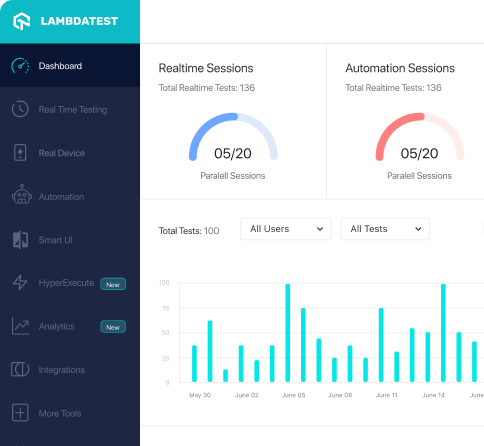How to use VerifyAlertPresentAction class of com.testsigma.automator.actions.mobile.ios.verify package
Best Testsigma code snippet using com.testsigma.automator.actions.mobile.ios.verify.VerifyAlertPresentAction
Source: VerifyAlertPresentAction.java
...3import org.openqa.selenium.Alert;4import org.openqa.selenium.support.ui.ExpectedConditions;5import org.openqa.selenium.support.ui.WebDriverWait;6import org.springframework.util.Assert;7public class VerifyAlertPresentAction extends MobileElementAction {8 private static final String SUCCESS_MESSAGE = "Successfully verified Alert's presence in current page.";9 private static final String ALERT_VERIFICATION_FAILURE = "There is no Alert in current page.";10 @Override11 public void execute() throws Exception {12 WebDriverWait waiter = new WebDriverWait(getDriver(), 30);13 Alert alert = waiter.until(ExpectedConditions.alertIsPresent());14 Assert.isTrue(alert != null, ALERT_VERIFICATION_FAILURE);15 setSuccessMessage(SUCCESS_MESSAGE);16 }17}...Source: CheckIfAlertIsPresentAction.java
1package com.testsigma.automator.actions.mobile.ios.ifconditional;2import com.testsigma.automator.actions.mobile.ios.verify.VerifyAlertPresentAction;3public class CheckIfAlertIsPresentAction extends VerifyAlertPresentAction {4}...VerifyAlertPresentAction
Using AI Code Generation
1import com.testsigma.automator.actions.mobile.ios.verify.VerifyAlertPresentAction;2import com.testsigma.automator.core.Automator;3import com.testsigma.automator.core.AutomatorFactory;4import com.testsigma.automator.core.AutomatorSettings;5import com.testsigma.automator.core.TestData;6import com.testsigma.automator.core.TestDataFactory;7import com.testsigma.automator.core.TestDataSettings;8import com.testsigma.automator.core.TestResult;9import com.testsigma.automator.core.TestResultFactory;10import com.testsigma.automator.core.TestResultSettings;11import com.testsigma.automator.core.TestRun;12import com.testsigma.automator.core.TestRunFactory;13import com.testsigma.automator.core.TestRunSettings;14import com.testsigma.automator.utils.TestRunUtils;15public class VerifyAlertPresentActionTest {16 public static void main(String[] args) {17 AutomatorSettings automatorSettings = new AutomatorSettings();18 automatorSettings.setDeviceName("iPhone 7 Plus");19 automatorSettings.setPlatformName("iOS");20 automatorSettings.setPlatformVersion("11.2");21 automatorSettings.setAutomationName("XCUITest");22 automatorSettings.setAppPackage("com.apple.mobilecal");23 automatorSettings.setAppActivity("com.apple.mobilecal.CalculVerifyAlertPresentAction
Using AI Code Generation
1package com.testsigma.automator.actions.mobile.ios.verify;2import org.openqa.selenium.WebDriver;3import org.openqa.selenium.WebElement;4import com.testsigma.automator.actions.Action;5import com.testsigma.automator.actions.ActionResult;6import com.testsigma.automator.actions.ActionType;7import com.testsigma.automator.actions.mobile.MobileAction;8import com.testsigma.automator.actions.mobile.MobileActionType;9import com.testsigma.automator.actions.mobile.MobileActionResult;10import com.testsigma.automator.actions.mobile.MobileActionType;11import com.testsigma.aVerifyAlertPresentAction
Using AI Code Generation
1import com.testsigma.automator.actions.mobile.ios.verify.VerifyAlertPresentAction;2import com.testsigma.automator.common.TestStep;3import com.testsigma.automator.common.TestStepResult;4import com.testsigma.automator.common.TestStepResultStatus;5import com.testsigma.automator.common.TestStepStatus;6import com.testsigma.automator.common.TestStepType;7import com.testsigma.automator.common.TestStepValue;8import com.testsigma.automator.common.ValueType;9import com.testsigma.automator.common.exceptions.TestStepException;10import com.testsigma.automator.common.exceptions.TestStepExceptionType;11import com.testsigma.automator.common.exceptions.TestStepRuntimeException;12import com.testsigma.automator.common.exceptions.TestStepRuntimeExceptionType;13import com.testsigma.automator.common.exceptions.TestStepValidationException;14import com.testsigma.automator.common.exceptions.TestStepValidationExceptionType;15import com.testsigma.automator.common.logging.Logger;16import com.testsigma.automator.common.logging.LoggerFactory;17import com.testsigma.automator.common.utils.TestStepUtils;18import com.testsigma.automator.common.utils.ValidationUtils;19import com.testsigma.automator.driver.Driver;20import com.testsigma.automator.driver.DriverType;21import com.testsigma.automator.driver.MobileDriver;22import com.testsigma.automator.driver.MobileDriverType;23public class VerifyAlertPresentAction extends BaseAction {24 private static final Logger logger = LoggerFactory.getLogger(VerifyAlertPresentAction.class);25 private static final String ACTION_NAME = "Verify Alert Present";26 private static final String ACTION_DESCRIPTION = "Verifies if an alert is present";27 private static final String ACTION_INPUT_ALERTPRESENT = "AlertPresent";28 private static final String ACTION_INPUT_ALERTNOTPRESENT = "AlertNotPresent";29 private static final String ACTION_INPUT_ALERTPRESENTMESSAGE = "AlertPresentMessage";30 private static final String ACTION_INPUT_ALERTNOTPRESENTMESSAGE = "AlertNotPresentMessage";31 private static final String ACTION_INPUT_TIMEOUT = "Timeout";32 private static final String ACTION_INPUT_TIMEOUTMESSAGE = "TimeoutMessage";33 private static final String ACTION_INPUT_WAITFORALERT = "WaitForAlert";34 private static final String ACTION_INPUT_WAITFORALERTMESSAGE = "WaitForAlertMessage";35 private static final String ACTION_INPUT_ALERTPRESENTMESSAGEVALUE = "AlertPresentMessageValue";36 private static final String ACTION_INPUT_ALERTNOTPRESENTMESSAGEVALUE = "AlertNotPresentMessageValue";VerifyAlertPresentAction
Using AI Code Generation
1VerifyAlertPresentAction verifyAlertPresentAction = new VerifyAlertPresentAction();2verifyAlertPresentAction.setDriver(driver);3verifyAlertPresentAction.setWaitTime(10);4verifyAlertPresentAction.setExpectedValue(true);5verifyAlertPresentAction.execute();6VerifyAlertPresentAction verifyAlertPresentAction = new VerifyAlertPresentAction();7verifyAlertPresentAction.setDriver(driver);8verifyAlertPresentAction.setWaitTime(10);9verifyAlertPresentAction.setExpectedValue(false);10verifyAlertPresentAction.execute();11VerifyAlertPresentAction verifyAlertPresentAction = new VerifyAlertPresentAction();12verifyAlertPresentAction.setDriver(driver);13verifyAlertPresentAction.setWaitTime(10);14verifyAlertPresentAction.setExpectedValue(true);15verifyAlertPresentAction.execute();16VerifyAlertPresentAction verifyAlertPresentAction = new VerifyAlertPresentAction();17verifyAlertPresentAction.setDriver(driver);18verifyAlertPresentAction.setWaitTime(10);19verifyAlertPresentAction.setExpectedValue(false);20verifyAlertPresentAction.execute();21VerifyAlertPresentAction verifyAlertPresentAction = new VerifyAlertPresentAction();22verifyAlertPresentAction.setDriver(driver);23verifyAlertPresentAction.setWaitTime(10);24verifyAlertPresentAction.setExpectedValue(true);25verifyAlertPresentAction.execute();26VerifyAlertPresentAction verifyAlertPresentAction = new VerifyAlertPresentAction();27verifyAlertPresentAction.setDriver(driver);28verifyAlertPresentAction.setWaitTime(10);29verifyAlertPresentAction.setExpectedValue(false);30verifyAlertPresentAction.execute();31VerifyAlertPresentAction verifyAlertPresentAction = new VerifyAlertPresentAction();32verifyAlertPresentAction.setDriver(driver);33verifyAlertPresentAction.setWaitTime(10);34verifyAlertPresentAction.setExpectedValue(true);35verifyAlertPresentAction.execute();VerifyAlertPresentAction
Using AI Code Generation
1VerifyAlertPresentAction verifyAlertPresentAction = new VerifyAlertPresentAction();2verifyAlertPresentAction.setAlertPresent(true);3verifyAlertPresentAction.setAlertMessage("Alert");4verifyAlertPresentAction.setAlertType("Alert");5verifyAlertPresentAction.setAlertTitle("Alert");6verifyAlertPresentAction.setAlertButton("OK");7verifyAlertPresentAction.setAlertButtonIndex(0);8verifyAlertPresentAction.setAlertButtonLabel("OK");9verifyAlertPresentAction.setAlertButtonLabels(new String[] {"OK"});10verifyAlertPresentAction.setAlertButtonName("OK");11verifyAlertPresentAction.setAlertButtonNames(new String[] {"OK"});12verifyAlertPresentAction.setAlertButtonValue("OK");13verifyAlertPresentAction.setAlertButtonValues(new String[] {"OK"});14verifyAlertPresentAction.setAlertButtons(new String[] {"OK"});15verifyAlertPresentAction.setAlertContext("Alert");16verifyAlertPresentAction.setAlertIsPresent(true);17verifyAlertPresentAction.setAlertName("Alert");18verifyAlertPresentAction.setAlertPresent(true);19verifyAlertPresentAction.setAlertText("Alert");20verifyAlertPresentAction.setAlertValue("Alert");Blogs
Check out the latest blogs from LambdaTest on this topic:
The sky’s the limit (and even beyond that) when you want to run test automation. Technology has developed so much that you can reduce time and stay more productive than you used to 10 years ago. You needn’t put up with the limitations brought to you by Selenium if that’s your go-to automation testing tool. Instead, you can pick from various test automation frameworks and tools to write effective test cases and run them successfully.
The rapid shift in the use of technology has impacted testing and quality assurance significantly, especially around the cloud adoption of agile development methodologies. With this, the increasing importance of quality and automation testing has risen enough to deliver quality work.
Did you know that according to Statista, the number of smartphone users will reach 18.22 billion by 2025? Let’s face it, digital transformation is skyrocketing and will continue to do so. This swamps the mobile app development market with various options and gives rise to the need for the best mobile app testing tools
There is just one area where each member of the software testing community has a distinct point of view! Metrics! This contentious issue sparks intense disputes, and most conversations finish with no definitive conclusion. It covers a wide range of topics: How can testing efforts be measured? What is the most effective technique to assess effectiveness? Which of the many components should be quantified? How can we measure the quality of our testing performance, among other things?
Pair testing can help you complete your testing tasks faster and with higher quality. But who can do pair testing, and when should it be done? And what form of pair testing is best for your circumstance? Check out this blog for more information on how to conduct pair testing to optimize its benefits.
Automation Testing Tutorials
Learn to execute automation testing from scratch with LambdaTest Learning Hub. Right from setting up the prerequisites to run your first automation test, to following best practices and diving deeper into advanced test scenarios. LambdaTest Learning Hubs compile a list of step-by-step guides to help you be proficient with different test automation frameworks i.e. Selenium, Cypress, TestNG etc.
LambdaTest Learning Hubs:
- JUnit Tutorial
- TestNG Tutorial
- Webdriver Tutorial
- WebDriverIO Tutorial
- Protractor Tutorial
- Selenium 4 Tutorial
- Jenkins Tutorial
- NUnit Tutorial
- Jest Tutorial
- Playwright Tutorial
- Cypress Tutorial
- PyTest Tutorial
YouTube
You could also refer to video tutorials over LambdaTest YouTube channel to get step by step demonstration from industry experts.
Most used methods in VerifyAlertPresentAction
Try LambdaTest Now !!
Get 100 minutes of automation test minutes FREE!!


